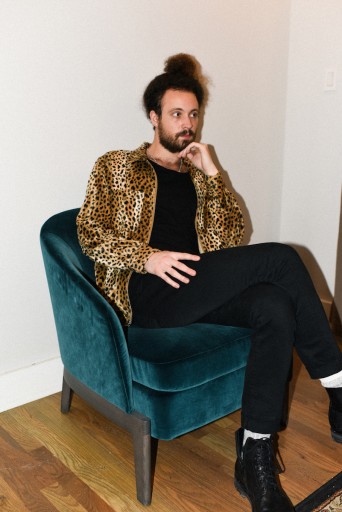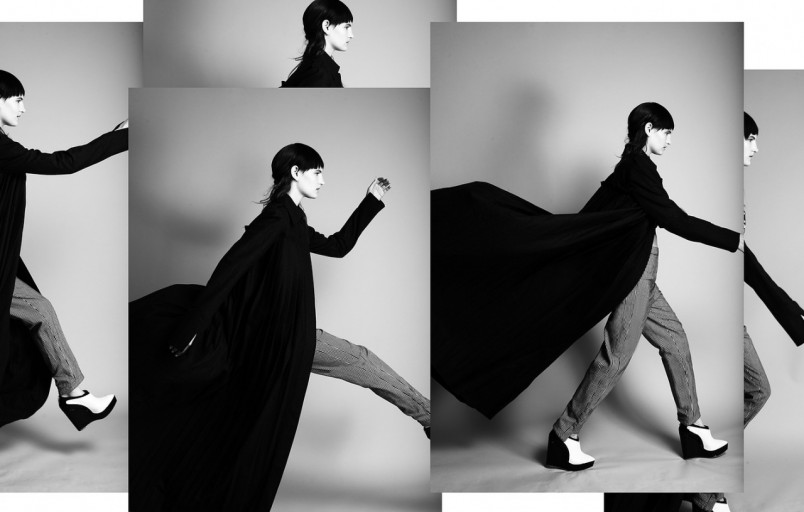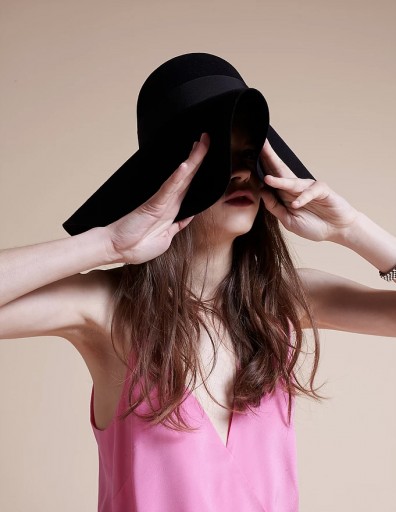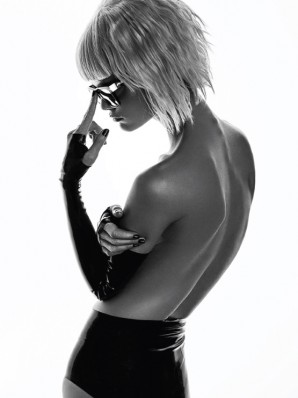"Cheng-Huai Chuang was introduced to fashion at a young age"
Branding in the Worlds of Art and Commerce According to Silvia Mella
Branding is everything. For an entrepreneur, it is the difference between viability and bankruptcy. On social media, we are all our own brands. Our choices in clothes, food, jobs, housing, friends and even romantic partners are all subject to branding’s influence. There was a time when advertising and fine arts occupied antagonistic spheres in the realm of creativity. Now, artists are entrepreneurs, and entrepreneurs utilize the arts to create their brand’s identity on social media. Silvia Mella is the woman that Fendi, Net-a-Porter, Vera Wang and Topshop call when they want help navigating the abstruse world of branding. Amidst her breakneck agenda of photoshoots and meetings, Silvia took a moment to share her insights with TWELV.
We heard that you were behind the scenes at the Met Gala working on a project for Vogue Thailand! Can you tell us about that?
Nichapat Suphap is a contributing editor of Vogue Thailand, and when she went to the Met Gala this year, it was a historic moment because she was the first Thai person to attend. She wore an original Peter Dundas couture gown– Peter is well known for making Beyonce’s 2017 Grammy dress. Nichapat got dressed for the ball in a room at The Mark Hotel, so we had a photographer there to document it, and the behind-the-scenes photos will appear in the print edition of Vogue Thailand.
We also heard that you are working on a project for Molteni, the Italian furniture company.
The #HouseofMolteni project was already underway before I got involved, so I shot homes in three cities, but there are 12 in all. I researched creative people on Instagram and found pictures of their homes with Molteni furniture, so we spoke to them, and the focus is really to ask ‘How do you feel in your home? Why did you choose your neighborhood?’ We shot in Brooklyn, Portland [Oregon] and Ghent [Belgium]. It is a really beautiful exploration of the notion of home and how we define our place of refuge.
In the 1990s, when you were growing up near Venice, Italy, internet branding did not exist. Can you walk us through the professional journey that brought you to where you are now?
I started out as a journalist, an editor. At university in Milan, I studied advertising and public relations. I interned at Muse Magazine in Italy when I was in university, and I continued on as Assistant Editor after graduation. Then I came to the U.S. and worked for Conde Nast Italia, reporting on what was happening in New York in fashion and the arts. Then I did my own publication, Idolize. It was a limited-edition release and came in a box and had images and interviews, photography, posters. Some of my clients started to see what I was doing for Idolize and asked me to produce content for them. I said yes to the first request, and haven’t stopped since then. For me, there are a lot of similarities between advertising and journalism--they are both about storytelling. English is not my mother tongue, so I had to find ways to tell stories through images and video.
You’ve worked with so many iconic creative minds, such as Marina Abramovic and Harold Koda. How did the Harold-Marina summit for Idolize come about?
I always want to work with talent I like. With Marina, I wanted her to be part of the second issue of Idolize, so I knew I had to approach her with a strong idea, and I thought it would be interesting if Marina and Harold did a conversation on beauty. The three of us met and they talked for two hours.They had an intimate and personal conversation– I really let them talk a lot without interrupting, and from that conversation, I curated the excerpts we used in Idolize.
A lot of your editorial images are very abstract, portraying more of lifestyle than highlighting a specific product– which is what strategic branding often entails. But I am often reminded by my friends outside the fashion industry that outlandish images in ads and on runways can be confusing to consumers. Is this balance ever an issue between you and your clients?
Some of my content is abstract because I don’t want to tell people what to do. I use the medium as a tool to communicate ideas in a language everyone can understand. Even though I am fascinated with clothes, shoes, and bags, that’s not why I do what I do. I like to make people think, and when people connect with the images, they become loyal to the brand. I find that when the message is not straight in your face, it makes you think more.
Before the 1990s, there was a distinct partition between the worlds of art and commerce. There was this punk rock ideology that artists should only care about creative expression, and not aspire to make money. Now it seems that every successful artist sells merchandise. Do you think that there is any downside to the modern fusion of art and commerce?
I know a lot of people think there is a downside to the commercial influence on the art world, but I don’t agree. For an artist, doing commercial work can only benefit them because they can make money to support their art. I think partnerships are a great way for artists to explore their talents through other entertainment channels, and they can make products that many people can afford to purchase, rather than selling only high-priced items to art collectors.
We are living in a time when people are hypersensitive about how women are portrayed in Hollywood and beyond. When you are working on a project with abstract imagery that can be interpreted in many ways, is there ever a conflict between political correctness and provocation? I am thinking about the striking Idolize short called No 1.001 in which Virginia Slaghekke meets an untimely demise.
I think people like me who work with media have to take responsibility for what we say, and the kind of message we put out. I don’t really care about being politically correct. If someone sees my work and is offended by the content, then I just assume that they are not in the audience I am trying to reach. I don’t mind if there are conflicting opinions. I want to touch my audience and open a dialogue.
I absolutely love the series of narrative shorts you’ve created. Where did the concept for the shorts come from, and how did you find your subjects?
When Cools was launching the editorial site, they wanted people to feel the world of downtown New York City because that’s where the company comes from. I was in Union Square talking to some dancers, and Victor Yellow came up to me and said, ‘Why are you talking to them? You should be talking to me. I’m good too.’ Then I learned about his childhood and his passion for dance and how it changed his life, and it was such a powerful narrative. Since I met him a year ago, he’s gone on to do so many things. He’s performed at the Apollo, and on different television shows. That’s one of the fun parts about my work. I meet random people and then I get to see them evolve over time.
Looking ahead to the future, what path do you hope your creativity will take? Do you envision yourself doing full-length documentary films if the right opportunity presented itself?
I don’t know if I would do an entire full-length documentary. It’s very different than what I’m doing now. One thing I would like to do is design my own products so that I can tell stories through the products. Recently, I had an entire idea about toothbrushes, but it doesn’t have to be about toothbrushes. It can be about anything. It can be about plates, dinnerware, anything. The important thing is the story.
Be sure to check out the soon-to-be-released third installment of the House of Molteni Series, and keep up with Silvia on her Instagram and website.
INTERVIEW BY KAREN FRAGALA-SMITH
PHOTOS COURTESY OF SILVIA MELLA
related posts
NEW TYPE #12: DROMe - MARIANNA ROSATI INTERVIEW
" I carry in my heart the values I've learned from my hometown - such as being true to myself and to my style"
IKEMEN #30: JORGE URENA
IKEMEN (ē´k´mɛn): Japanese Slang
"REALLY, REALLY, RIDICULOUSLY GOOD LOOKING PEOPLE"
NEW TYPE #11: LODOVICO ZORDANAZZO INTERVIEW
TWELV Magazine sat down with Lodovico Zordanazzo during his NYC visit to discuss his new collection and unique perspective on shoe design.
NEW TYPE #9: J.ELSTER - JENNIFER ELSTER Interview
TWELV Magazine recently visited filmmaker and designer, Jennifer Elster, at her studio, The Development.
NEW TYPE #8: MORGANE LE FAY - Liliana Casabal Interview
Noritaka Tatehana Exclusive Interview
The talented young Japanese designer, Noritaka Tatehana, who collaborated with Iris Van Herpen to design Lady Gaga’s shoes.
CHAOS CHAOS Interview
Formerly known as Smoosh, Asy and Chloe Saavedra of Chaos Chaos have always been a sister-sister duo.
THE KNOCKS Takes Tokyo
Recently, electro-pop duo, The Knocks, visited Japan to perform in the ARC+TWELV party at ARC, a newly opened venue in Tokyo.
CAVERNS Interview
TWELV had privilage of chatting with our friends from the band Caverns. The trio hail from NYC and are pretty much all over the music scene here!
Michael Phillips Moskowitz, eBay Chief Curator & Ed. Director, Interview
TWELV Magazine had the pleasure of connecting with Michael Phillips Moskowitz, the Global Chief Curator & Editorial Director at eBay.
NEW TYPE #7: EKAT - Katya INTERVIEW
"Introducing a new generation of designers"
Mai Mukaida Interview
Makeup Artist / CEO, Lalitpur.
Believes in the power of cosmetic
and lives with women in Nepal.
M KOUGER INTERVIEW: Farmhouse
With the fabulous Chloe 81, the oysterrific Chloe 81 Blue Room and the recently opened Farmhouse Restaurant, M Kouger has established an essential trifecta of entertainment in NYC’...
NEW TYPE #6: BERENIK- Veronica Brusa INTERVIEW
"Introducing a new generation of designers"
REI SHITO INTERVIEW
Street Fashion Photographer
and Style Blogger.
Loves in Street and the Beyond
Interview: The Refined Opulence of Hoorsenbuhs
The Hoorsenbuhs name has become synonymous with exclusivity, craftsmanship, and opulence. Once nothing more than the ambitious brainchild of creator Robert Keith, the brand has become a staple in...
NEW TYPE #5: HAZE Collection INTERVIEW
"Introducing a new generation of designers"
IKEMEN #29: JAY XERO
IKEMEN (ē´k´mɛn): Japanese Slang
"REALLY, REALLY, RIDICULOUSLY GOOD LOOKING PEOPLE"
Travis Bass Interview
New York’s Greenwich Village is now home to a new and amazing club created by the ultimate party planner/Pop Up Club designer, Travis Bass, called ZAZOU.
NEW TYPE #4: SAUNDER - Emily Saunders interview
"Introducing a new generation of designers"
NEW TYPE #3: GLORIA YU interview
"Introducing a new generation of designers"
IKEMEN #28: CJ Swanton & Mariko Derpa
IKEMEN (ē´k´mɛn): Japanese Slang
"REALLY, REALLY, RIDICULOUSLY GOOD LOOKING PEOPLE"
NEW TYPE #2: VINTI ANDREWS - Vinti Tan and Paul Andrews INTERVIEW
"Introducing a new generation of designers"
NEW TYPE #1: DEJAN DESPOTOVIC INTERVIEW
"Introducing a new generation of designers"
BEHIND THE SCENES #3: KATSUYA KAMO
TWELV's Behind the Scenes takes a step back and visits the masterminds behind the camera.
SUK CHAI INTERVIEW "SCHAI"
“My hands and eyes ooze desire to create when I touch something special. When I touch the “right” fabric, I usually close my eyes and visualize all the things I can create.”
IKEMEN #27: M KOUGER
IKEMEN (ē´k´mɛn): Japanese Slang
"REALLY, REALLY, RIDICULOUSLY GOOD LOOKING PEOPLE"
NORITAKA TATEHANA EXCLUSIVE INTERVIEW
NORITAKA TATEHANA EXCLUSIVE INTERVIEW
IKEMEN #26: KANAMI KAWAGUCHI
IKEMEN (ē´k´mɛn): Japanese Slang
"REALLY, REALLY, RIDICULOUSLY GOOD LOOKING PEOPLE"
MAISON KITSUNé INTERVIEW
During their first ever showing in New York Fashion Week, TWELV Magazine and I got to catch up with the talented duo behind the remarkable brand, MAISON KITSUNÉ, We spoke with Gildas Loaëc and...
MARIA HEDMARK INTERVIEW
Although Swedish transplant MARIA HEDMARK has only been in New York City for three years, her line, LINIE NYC, takes its name straight from the city that never sleeps.
IKEMEN #25: LANDON MILLER
IKEMEN (ē´k´mɛn): Japanese Slang
"REALLY, REALLY, RIDICULOUSLY GOOD LOOKING PEOPLE"














































